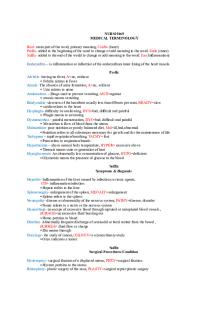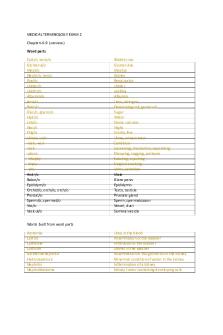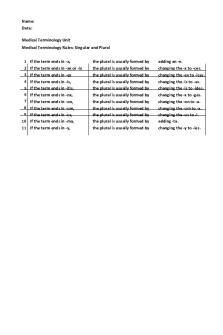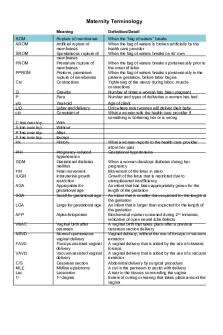Medical terminology 3 - Very helpful PDF

| Title | Medical terminology 3 - Very helpful |
|---|---|
| Course | Anatomical Imaging |
| Institution | Queensland University of Technology |
| Pages | 2 |
| File Size | 165.3 KB |
| File Type | |
| Total Downloads | 20 |
| Total Views | 132 |
Summary
Very helpful...
Description
Medical terminology 3 – commonly used prefixes Why this resource might be useful? Speaking the language of science and medicine is an essential requirement for all health professionals and life scientists; it is the basis for clear and accurate communication. Here we focus on some of the more commonly used prefixes in medical terminology.
Prefixes in medical terminology In the worksheet Medical Terminology 2, we covered some of the commonly used root words. The root words are the base of the term and provide a good indication of the meaning of the term. The addition of another word part (a prefix) to the beginning of an existing term is used to alter its meaning. For example, the word lateral means ‘side’. Using the following prefixes, we can generate new terms; Prefix bi-
Meaning two
Term bilateral
Meaning two sides
uni-
one
unilateral
one side
contra-
opposite, against
contralateral
opposite side
Here is a list of word parts commonly used as prefixes in medical and scientific terminology. You may be surprised to see how many you already know and use on a daily basis! Prefix
Meaning
Example
a-
Without, not
Apnea
ante-
Before
Antenatal
anti-
Against
Antibody
autobi-
Self Two, double
Autoimmune Bicuspid
dys-
Bad, difficult
Dysmenorrhea
endo-
Within
Endocrinology
ex-, exohemi-
Out, outside Half
Excision Hemisphere
hyper-
Over, above
Hyperactive
hypo-
Under, below
Hypodermic
interintra-
Between Within
Interstitial Intracranial
macro-
Large
Macrophage
micro-
Small
Microscope
neooligo-
New Few, scanty
Neonatal Oliguria
para-
Near, aside
Parathyroid
peri-
Around, surrounding
Periodontal
polypost-
Many After
Polydactyly Postmortem
pre-
Before
Premature
semi-
Half
Semiconscious
transAcross, through Transverse This is by no means an exhaustive list. If you would like to look at more examples of prefixes in medical terminology, check out some of the websites and textbook references listed in the resources section of this worksheet.
Revision/Practice exercises
1.
For each of the root words listed in the table, think of another term that uses that root. Then try and deduce the meaning of that term based on what you have learnt here.
2.
Identify and define the prefix in each of the following terms:
a. b. c. d. e. f. g. 3.
Prefix __________ __________ __________ __________ __________ __________ __________
orthopedics pandemic superficial neocortex isometric regurgitate euthyroidism
Meaning of Prefix _________________________________ _________________________________ _________________________________ _________________________________ _________________________________ _________________________________ _________________________________
Write the opposite of the following terms (hint: think about the prefix) a. hypotension b. microscopic c. homogenous
Other resources you might find useful Practice makes perfect, and is the key to learning any new language. We have designed a series of modules that you can download and progress through at your own pace to develop and test your understanding of medical terminology. You can access these via the STIMulate community blackboard page (go to Science Resources → science vocabulary development). A great strategy to get you thinking about the terminology that is specific to your field of study is to generate your own glossary. This may be a separate notebook or file (even a note on your phone!) in which you jot down unfamiliar terms as they come up in lectures or class readings. Think about the word parts of these new terms – are there any components of the term you already recognise that might give some insight into the meaning. Here are a couple of websites that offer lists of prefixes, suffixes and roots specific to medical terminology and activities to test your understanding: 1.
QUIZLET (http://quizlet.com/). Search for lists of medical terminology relevant to anatomy, nursing, optometry, etc or create your own list. Lists can used to generate flashcards or games. Great study tool if you need a break from the books for 10 mins but want to stay on task! Lists of medical terminology prefixes, suffixes and roots (links also available on the STIMulate BB page, under science resources → vocabulary development).
2.
UMN medical terminology resource (http://msjensen.cehd.umn.edu/1135/Worksheets/medterms/default.html) Great resource from the University of Minnesota – includes lists of commonly used prefixes, suffixes and roots, as well as activities to test your understanding (link also available on the STIMulate BB page, under science resources → vocabulary development).
Textbooks (all available from QUT library) Chabner, D.-E. (2009). Medical terminology : a short course. St. Louis, Mo., Saunders Elsevier. Lippincott Williams & Wilkins. (2009). Medical terminology made incredibly easy! Philadelphia, Wolters Kluwer Health/Lippincott Williams & Wilkins. Patton, K. T. and G. A. Thibodeau (2010). Anatomy & physiology. St. Louis, Mo., Mosby/Elsevier. (Look for the "Quick Guide to the Language of Science and Medicine" which is a separate offering to the text) Answers to revision questions: 2. a. ortho- (straight, correct, upright); b. pan- (all); c. super- (above, excess); d. neo- (new); e. iso- (same, equal); re- (back, again); g. eu- (true, easy). 3. a. hypertension
b. macroscopic
c. heterogenous
If you require further assistance feel free to visit a STIMulate drop-in session or contact us at [email protected]...
Similar Free PDFs

Medical Terminology Chapter 3
- 2 Pages

Chapter 3 - MEDICAL TERMINOLOGY
- 19 Pages

Medical Terminology
- 50 Pages

OB Project - VERY HELPFUL
- 18 Pages

Medical Terminology
- 6 Pages

Medical Terminology
- 2 Pages

Medical Terminology
- 4 Pages

WWTP 2 - very helpful
- 6 Pages

Medical Terminology EXAM 2
- 4 Pages

Medical terminology Modules
- 158 Pages

Medical Terminology Terms
- 22 Pages

Medical Terminology-Plurals Quiz
- 3 Pages

Medical terminology 17
- 4 Pages
Popular Institutions
- Tinajero National High School - Annex
- Politeknik Caltex Riau
- Yokohama City University
- SGT University
- University of Al-Qadisiyah
- Divine Word College of Vigan
- Techniek College Rotterdam
- Universidade de Santiago
- Universiti Teknologi MARA Cawangan Johor Kampus Pasir Gudang
- Poltekkes Kemenkes Yogyakarta
- Baguio City National High School
- Colegio san marcos
- preparatoria uno
- Centro de Bachillerato Tecnológico Industrial y de Servicios No. 107
- Dalian Maritime University
- Quang Trung Secondary School
- Colegio Tecnológico en Informática
- Corporación Regional de Educación Superior
- Grupo CEDVA
- Dar Al Uloom University
- Centro de Estudios Preuniversitarios de la Universidad Nacional de Ingeniería
- 上智大学
- Aakash International School, Nuna Majara
- San Felipe Neri Catholic School
- Kang Chiao International School - New Taipei City
- Misamis Occidental National High School
- Institución Educativa Escuela Normal Juan Ladrilleros
- Kolehiyo ng Pantukan
- Batanes State College
- Instituto Continental
- Sekolah Menengah Kejuruan Kesehatan Kaltara (Tarakan)
- Colegio de La Inmaculada Concepcion - Cebu


